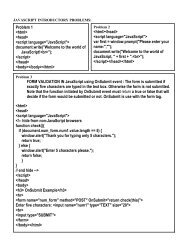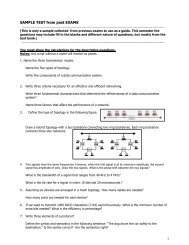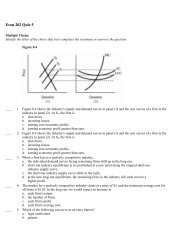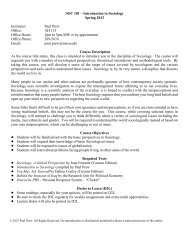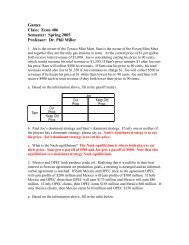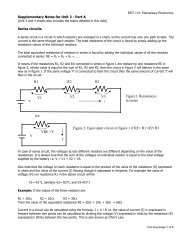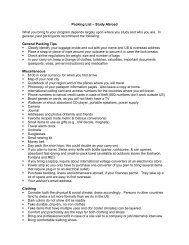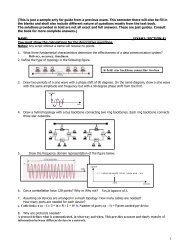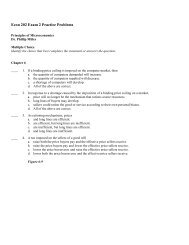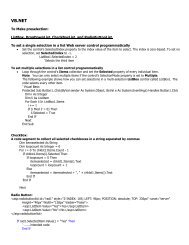- Page 6 and 7: viCONTENTS5.5 Inheritance and Polym
- Page 8 and 9: viiiCONTENTS7.5 Multi-dimensional A
- Page 10 and 11: xCONTENTS11.1.5 The Scanner Class .
- Page 12 and 13: xiiCONTENTS
- Page 14 and 15: xivPrefaceChapter 7. Chapter 8 mark
- Page 16 and 17: xviPreface
- Page 18 and 19: 2 CHAPTER 1. THE MENTAL LANDSCAPElo
- Page 22: 6 CHAPTER 1. THE MENTAL LANDSCAPEmu
- Page 25 and 26: 1.5. OBJECT-ORIENTED PROGRAMMING 9i
- Page 27 and 28: 1.5. OBJECT-ORIENTED PROGRAMMING 11
- Page 29 and 30: 1.6. THE MODERN USER INTERFACE 13an
- Page 31 and 32: Manual A5LCY-I-2011Felkodsdiagnos v
- Page 33 and 34: Quiz 17Quiz on Chapter 11. One of t
- Page 35 and 36: Chapter 2Programming in the Small I
- Page 37 and 38: 2.1. THE BASIC JAVA APPLICATION 21m
- Page 39 and 40: 2.2. VARIABLES AND TYPES 23Accordin
- Page 41 and 42: 2.2. VARIABLES AND TYPES 25(whole n
- Page 43 and 44: 2.2. VARIABLES AND TYPES 27in some
- Page 45 and 46: 2.3. OBJECTS AND SUBROUTINES 29obje
- Page 47 and 48: 2.3. OBJECTS AND SUBROUTINES 31Syst
- Page 49 and 50: 2.3. OBJECTS AND SUBROUTINES 33Then
- Page 51 and 52: 2.3. OBJECTS AND SUBROUTINES 35An e
- Page 53 and 54: 2.4. TEXT INPUT AND OUTPUT 37Along
- Page 55 and 56: 2.4. TEXT INPUT AND OUTPUT 392.4.3
- Page 57 and 58: 2.4. TEXT INPUT AND OUTPUT 41distin
- Page 59 and 60: 2.4. TEXT INPUT AND OUTPUT 43value
- Page 61 and 62: 2.5. DETAILS OF EXPRESSIONS 45The M
- Page 63 and 64: 2.5. DETAILS OF EXPRESSIONS 47to co
- Page 65 and 66: 2.5. DETAILS OF EXPRESSIONS 49A = 1
- Page 67 and 68: 2.6. PROGRAMMING ENVIRONMENTS 51Ope
- Page 69 and 70: 2.6. PROGRAMMING ENVIRONMENTS 53jav
- Page 71 and 72:
2.6. PROGRAMMING ENVIRONMENTS 55the
- Page 73 and 74:
2.6. PROGRAMMING ENVIRONMENTS 57Som
- Page 75 and 76:
Exercises 59since 1342 is equal to
- Page 77 and 78:
Chapter 3Programming in the Small I
- Page 79 and 80:
3.1. BLOCKS, LOOPS, AND BRANCHES 63
- Page 81 and 82:
3.1. BLOCKS, LOOPS, AND BRANCHES 65
- Page 83 and 84:
3.2. ALGORITHM DEVELOPMENT 67top-do
- Page 85 and 86:
3.2. ALGORITHM DEVELOPMENT 69the wh
- Page 87 and 88:
3.2. ALGORITHM DEVELOPMENT 71number
- Page 89 and 90:
3.3. WHILE AND DO..WHILE 73The poin
- Page 91 and 92:
3.3. WHILE AND DO..WHILE 75Add the
- Page 93 and 94:
3.3. WHILE AND DO..WHILE 77Since th
- Page 95 and 96:
3.4. THE FOR STATEMENT 79the loop t
- Page 97 and 98:
3.4. THE FOR STATEMENT 81Usually, t
- Page 99 and 100:
3.4. THE FOR STATEMENT 833.4.2 Exam
- Page 101 and 102:
3.4. THE FOR STATEMENT 853.4.3 Nest
- Page 103 and 104:
3.4. THE FOR STATEMENT 87public cla
- Page 105 and 106:
3.5. THE IF STATEMENT 893.5 The if
- Page 107 and 108:
3.5. THE IF STATEMENT 91else if (
- Page 109 and 110:
3.5. THE IF STATEMENT 93converting
- Page 111 and 112:
3.5. THE IF STATEMENT 95TextIO.putl
- Page 113 and 114:
3.6. THE SWITCH STATEMENT 97that th
- Page 115 and 116:
3.6. THE SWITCH STATEMENT 99switch
- Page 117 and 118:
3.7. EXCEPTIONS AND TRY..CATCH 101i
- Page 119 and 120:
3.7. EXCEPTIONS AND TRY..CATCH 103t
- Page 121 and 122:
3.8. GUI PROGRAMMING 105small! Appl
- Page 123 and 124:
3.8. GUI PROGRAMMING 107The applet
- Page 125 and 126:
3.8. GUI PROGRAMMING 109}}The “im
- Page 127 and 128:
Exercises 111Exercises for Chapter
- Page 129 and 130:
Exercises 113Call this file Checker
- Page 131 and 132:
Quiz 11512. What output is produced
- Page 133 and 134:
Chapter 4Programming in the Large I
- Page 135 and 136:
4.2. STATIC SUBROUTINES AND VARIABL
- Page 137 and 138:
4.2. STATIC SUBROUTINES AND VARIABL
- Page 139 and 140:
4.2. STATIC SUBROUTINES AND VARIABL
- Page 141 and 142:
4.2. STATIC SUBROUTINES AND VARIABL
- Page 143 and 144:
4.3. PARAMETERS 127TextIO.putln();}
- Page 145 and 146:
4.3. PARAMETERS 129A formal paramet
- Page 147 and 148:
4.3. PARAMETERS 131break them up in
- Page 149 and 150:
4.3. PARAMETERS 133parameters. The
- Page 151 and 152:
4.4. RETURN VALUES 135return type.)
- Page 153 and 154:
4.4. RETURN VALUES 137return ’F
- Page 155 and 156:
4.4. RETURN VALUES 139* startingVal
- Page 157 and 158:
4.5. APIS, PACKAGES, AND JAVADOC 14
- Page 159 and 160:
4.5. APIS, PACKAGES, AND JAVADOC 14
- Page 161 and 162:
4.5. APIS, PACKAGES, AND JAVADOC 14
- Page 163 and 164:
4.6. MORE ON PROGRAM DESIGN 147of t
- Page 165 and 166:
4.6. MORE ON PROGRAM DESIGN 149* In
- Page 167 and 168:
4.6. MORE ON PROGRAM DESIGN 151}mos
- Page 169 and 170:
4.7. THE TRUTH ABOUT DECLARATIONS 1
- Page 171 and 172:
4.7. THE TRUTH ABOUT DECLARATIONS 1
- Page 173 and 174:
4.7. THE TRUTH ABOUT DECLARATIONS 1
- Page 175 and 176:
4.7. THE TRUTH ABOUT DECLARATIONS 1
- Page 177 and 178:
Exercises 161Exercises for Chapter
- Page 179 and 180:
Exercises 163will call Mosaic.setCo
- Page 181 and 182:
Chapter 5Programming in the Large I
- Page 183 and 184:
5.1. OBJECTS AND INSTANCE METHODS 1
- Page 185 and 186:
5.1. OBJECTS AND INSTANCE METHODS 1
- Page 187 and 188:
5.1. OBJECTS AND INSTANCE METHODS 1
- Page 189 and 190:
5.2. CONSTRUCTORS AND OBJECT INITIA
- Page 191 and 192:
5.2. CONSTRUCTORS AND OBJECT INITIA
- Page 193 and 194:
5.2. CONSTRUCTORS AND OBJECT INITIA
- Page 195 and 196:
5.3. PROGRAMMING WITH OBJECTS 1795.
- Page 197 and 198:
5.3. PROGRAMMING WITH OBJECTS 181Ma
- Page 199 and 200:
5.3. PROGRAMMING WITH OBJECTS 183so
- Page 201 and 202:
5.4. PROGRAMMING EXAMPLE: CARD, HAN
- Page 203 and 204:
5.4. PROGRAMMING EXAMPLE: CARD, HAN
- Page 205 and 206:
5.4. PROGRAMMING EXAMPLE: CARD, HAN
- Page 207 and 208:
5.4. PROGRAMMING EXAMPLE: CARD, HAN
- Page 209 and 210:
5.4. PROGRAMMING EXAMPLE: CARD, HAN
- Page 211 and 212:
5.5. INHERITANCE AND POLYMORPHISM 1
- Page 213 and 214:
5.5. INHERITANCE AND POLYMORPHISM 1
- Page 215 and 216:
5.5. INHERITANCE AND POLYMORPHISM 1
- Page 217 and 218:
5.5. INHERITANCE AND POLYMORPHISM 2
- Page 219 and 220:
5.5. INHERITANCE AND POLYMORPHISM 2
- Page 221 and 222:
5.6. THIS AND SUPER 205to this exam
- Page 223 and 224:
5.6. THIS AND SUPER 207x in the sup
- Page 225 and 226:
5.7. INTERFACES, NESTED CLASSES, AN
- Page 227 and 228:
5.7. INTERFACES, NESTED CLASSES, AN
- Page 229 and 230:
5.7. INTERFACES, NESTED CLASSES, AN
- Page 231 and 232:
5.7. INTERFACES, NESTED CLASSES, AN
- Page 233 and 234:
5.7. INTERFACES, NESTED CLASSES, AN
- Page 235 and 236:
5.7. INTERFACES, NESTED CLASSES, AN
- Page 237 and 238:
Exercises 221numbers have been ente
- Page 239 and 240:
Quiz 223Quiz on Chapter 51. Object-
- Page 241 and 242:
Chapter 6Introduction to GUI Progra
- Page 243 and 244:
6.1. THE BASIC GUI APPLICATION 227}
- Page 245 and 246:
6.1. THE BASIC GUI APPLICATION 229p
- Page 247 and 248:
6.2. APPLETS AND HTML 231and listen
- Page 249 and 250:
6.2. APPLETS AND HTML 233}}content.
- Page 251 and 252:
6.2. APPLETS AND HTML 235This says
- Page 253 and 254:
6.2. APPLETS AND HTML 237. (This is
- Page 255 and 256:
6.2. APPLETS AND HTML 239This assum
- Page 257 and 258:
6.3. GRAPHICS AND PAINTING 241or fr
- Page 259 and 260:
6.3. GRAPHICS AND PAINTING 243even
- Page 261 and 262:
6.3. GRAPHICS AND PAINTING 245Java
- Page 263 and 264:
6.3. GRAPHICS AND PAINTING 247These
- Page 265 and 266:
6.3. GRAPHICS AND PAINTING 249* of
- Page 267 and 268:
6.4. MOUSE EVENTS 251* The actual c
- Page 269 and 270:
6.4. MOUSE EVENTS 2531. Put the imp
- Page 271 and 272:
6.4. MOUSE EVENTS 255events from th
- Page 273 and 274:
6.4. MOUSE EVENTS 257import java.aw
- Page 275 and 276:
6.4. MOUSE EVENTS 259If you want yo
- Page 277 and 278:
6.4. MOUSE EVENTS 261I will discuss
- Page 279 and 280:
6.4. MOUSE EVENTS 263}public static
- Page 281 and 282:
6.5. TIMER AND KEYBOARD EVENTS 265e
- Page 283 and 284:
6.5. TIMER AND KEYBOARD EVENTS 267g
- Page 285 and 286:
6.5. TIMER AND KEYBOARD EVENTS 269u
- Page 287 and 288:
6.5. TIMER AND KEYBOARD EVENTS 271i
- Page 289 and 290:
6.6. BASIC COMPONENTS 273method tha
- Page 291 and 292:
6.6. BASIC COMPONENTS 275• comp.s
- Page 293 and 294:
6.6. BASIC COMPONENTS 2776.6.3 JChe
- Page 295 and 296:
6.6. BASIC COMPONENTS 279The parame
- Page 297 and 298:
6.6. BASIC COMPONENTS 281If the par
- Page 299 and 300:
6.7. BASIC LAYOUT 2836.7.1 Basic La
- Page 301 and 302:
6.7. BASIC LAYOUT 285If a container
- Page 303 and 304:
6.7. BASIC LAYOUT 287(The source co
- Page 305 and 306:
6.7. BASIC LAYOUT 289public void st
- Page 307 and 308:
6.7. BASIC LAYOUT 291}} // end acti
- Page 309 and 310:
6.7. BASIC LAYOUT 2936.7.6 A Little
- Page 311 and 312:
6.7. BASIC LAYOUT 295deck = new Dec
- Page 313 and 314:
6.8. MENUS AND DIALOGS 297As the us
- Page 315 and 316:
6.8. MENUS AND DIALOGS 299Using men
- Page 317 and 318:
6.8. MENUS AND DIALOGS 301dialog bo
- Page 319 and 320:
6.8. MENUS AND DIALOGS 303The last
- Page 321 and 322:
6.8. MENUS AND DIALOGS 305that all
- Page 323 and 324:
Exercises 3074. In Exercise 6.3, yo
- Page 325 and 326:
Exercises 309You can find a descrip
- Page 327 and 328:
Quiz 311Quiz on Chapter 61. Program
- Page 329 and 330:
Chapter 7ArraysComputers get a lot
- Page 331 and 332:
(5)list.lengthlist[2]list[3]list: l
- Page 333 and 334:
7.1. CREATING AND USING ARRAYS 317T
- Page 335 and 336:
7.2. PROGRAMMING WITH ARRAYS 319dou
- Page 337 and 338:
7.2. PROGRAMMING WITH ARRAYS 321for
- Page 339 and 340:
7.2. PROGRAMMING WITH ARRAYS 323wil
- Page 341 and 342:
7.2. PROGRAMMING WITH ARRAYS 325is
- Page 343 and 344:
7.2. PROGRAMMING WITH ARRAYS 327}ra
- Page 345 and 346:
7.3. DYNAMIC ARRAYS AND ARRAYLISTS
- Page 347 and 348:
7.3. DYNAMIC ARRAYS AND ARRAYLISTS
- Page 349 and 350:
7.3. DYNAMIC ARRAYS AND ARRAYLISTS
- Page 351 and 352:
7.3. DYNAMIC ARRAYS AND ARRAYLISTS
- Page 353 and 354:
7.3. DYNAMIC ARRAYS AND ARRAYLISTS
- Page 355 and 356:
7.3. DYNAMIC ARRAYS AND ARRAYLISTS
- Page 357 and 358:
7.3. DYNAMIC ARRAYS AND ARRAYLISTS
- Page 359 and 360:
7.4. SEARCHING AND SORTING 343The V
- Page 361 and 362:
7.4. SEARCHING AND SORTING 345* Sea
- Page 363 and 364:
7.4. SEARCHING AND SORTING 347* @re
- Page 365 and 366:
SortedItems Itemsstilltobesorted St
- Page 367 and 368:
7.4. SEARCHING AND SORTING 351}int
- Page 369 and 370:
0 12 !1 7 !3 5 !5 !2 2 !9 17.5. MUL
- Page 371 and 372:
7.5. MULTI-DIMENSIONAL ARRAYS 355To
- Page 373 and 374:
7.5. MULTI-DIMENSIONAL ARRAYS 357fo
- Page 375 and 376:
7.5. MULTI-DIMENSIONAL ARRAYS 359bo
- Page 377 and 378:
7.5. MULTI-DIMENSIONAL ARRAYS 361if
- Page 379 and 380:
7.5. MULTI-DIMENSIONAL ARRAYS 363}}
- Page 381 and 382:
Exercises 365complete polygon. Draw
- Page 383 and 384:
Exercises 367Each of the three subc
- Page 385 and 386:
Exercises 369}r += dirX; // Go on t
- Page 387 and 388:
Quiz 3719. Write a complete subrout
- Page 389 and 390:
Chapter 8Correctness and Robustness
- Page 391 and 392:
8.1. INTRODUCTION TO CORRECTNESS AN
- Page 393 and 394:
8.1. INTRODUCTION TO CORRECTNESS AN
- Page 395 and 396:
8.2. WRITING CORRECT PROGRAMS 379su
- Page 397 and 398:
8.2. WRITING CORRECT PROGRAMS 381i
- Page 399 and 400:
8.2. WRITING CORRECT PROGRAMS 383in
- Page 401 and 402:
8.3. EXCEPTIONS AND TRY..CATCH 385}
- Page 403 and 404:
Throwable ErrorSocketException EOFE
- Page 405 and 406:
8.3. EXCEPTIONS AND TRY..CATCH 389e
- Page 407 and 408:
8.3. EXCEPTIONS AND TRY..CATCH 391T
- Page 409 and 410:
8.3. EXCEPTIONS AND TRY..CATCH 3938
- Page 411 and 412:
8.3. EXCEPTIONS AND TRY..CATCH 395e
- Page 413 and 414:
8.4. ASSERTIONS 397there is a chanc
- Page 415 and 416:
8.5. INTRODUCTION TO THREADS 399On
- Page 417 and 418:
8.5. INTRODUCTION TO THREADS 401}}S
- Page 419 and 420:
8.5. INTRODUCTION TO THREADS 403pub
- Page 421 and 422:
8.5. INTRODUCTION TO THREADS 405Cou
- Page 423 and 424:
8.5. INTRODUCTION TO THREADS 407met
- Page 425 and 426:
8.5. INTRODUCTION TO THREADS 409rea
- Page 427 and 428:
8.5. INTRODUCTION TO THREADS 411}//
- Page 429 and 430:
8.6. ANALYSIS OF ALGORITHMS 413(By
- Page 431 and 432:
8.6. ANALYSIS OF ALGORITHMS 415and
- Page 433 and 434:
log(n) n*log(n) n n/log(n) 2 n8.6.
- Page 435 and 436:
Exercises 419Exercises for Chapter
- Page 437 and 438:
Exercises 421L 50XL 40Write a class
- Page 439 and 440:
Exercises 4236. Exercise 3.2 asked
- Page 441 and 442:
Quiz 425Theincrement() method is sy
- Page 443 and 444:
Chapter 9Linked Data Structures and
- Page 445 and 446:
9.1. RECURSION 429* return -1. Prec
- Page 447 and 448:
9.1. RECURSION 431of the disks have
- Page 449 and 450:
than23lietoitsleftandnumbersgreater
- Page 451 and 452:
9.1. RECURSION 435}}As usual, we ha
- Page 453 and 454:
9.1. RECURSION 437// the blobs that
- Page 455 and 456:
9.2. LINKED DATA STRUCTURES 4399.2
- Page 457 and 458:
Foralisttobeuseful,theremustbeavari
- Page 459 and 460:
9.2. LINKED DATA STRUCTURES 443proc
- Page 461 and 462:
previous:runner:9.2. LINKED DATA ST
- Page 463 and 464:
9.2. LINKED DATA STRUCTURES 447If y
- Page 465 and 466:
9.3. STACKS, QUEUES, AND ADTS 4499.
- Page 467 and 468:
9.3. STACKS, QUEUES, AND ADTS 451st
- Page 469 and 470:
9.3. STACKS, QUEUES, AND ADTS 453li
- Page 471 and 472:
9.3. STACKS, QUEUES, AND ADTS 455
- Page 473 and 474:
9.3. STACKS, QUEUES, AND ADTS 457Er
- Page 475 and 476:
9.4. BINARY TREES 459Postfix expres
- Page 477 and 478:
9.4. BINARY TREES 461return 0; // T
- Page 479 and 480:
oot:alicebilljudyfredmarytom9.4. BI
- Page 481 and 482:
9.4. BINARY TREES 465// Yes, the it
- Page 483 and 484:
Atreethatrepresentstheexpression 3*
- Page 485 and 486:
9.4. BINARY TREES 469abstract class
- Page 487 and 488:
9.5. A SIMPLE RECURSIVE DESCENT PAR
- Page 489 and 490:
9.5. A SIMPLE RECURSIVE DESCENT PAR
- Page 491 and 492:
9.5. A SIMPLE RECURSIVE DESCENT PAR
- Page 493 and 494:
9.5. A SIMPLE RECURSIVE DESCENT PAR
- Page 495 and 496:
Exercises 479Exercises for Chapter
- Page 497 and 498:
Exercises 481where can be either a
- Page 499 and 500:
Quiz 483 ::= | "(" [ ]... ")"wher
- Page 501 and 502:
Chapter 10Generic Programming andCo
- Page 503 and 504:
10.1. GENERIC PROGRAMMING 48710.1.2
- Page 505 and 506:
10.1. GENERIC PROGRAMMING 48910.1.4
- Page 507 and 508:
10.1. GENERIC PROGRAMMING 49110.1.5
- Page 509 and 510:
10.1. GENERIC PROGRAMMING 493obj1.e
- Page 511 and 512:
10.1. GENERIC PROGRAMMING 495}}.. /
- Page 513 and 514:
10.2. LISTS AND SETS 497Operations
- Page 515 and 516:
10.2. LISTS AND SETS 499ListIterato
- Page 517 and 518:
10.2. LISTS AND SETS 501even though
- Page 519 and 520:
10.2. LISTS AND SETS 50310.2.4 Enum
- Page 521 and 522:
10.3. MAPS 50510.3.1 The Map Interf
- Page 523 and 524:
10.3. MAPS 507}Or we could do the s
- Page 525 and 526:
10.3. MAPS 509Subsets and submaps a
- Page 527 and 528:
10.4. PROGRAMMING WITH THE COLLECTI
- Page 529 and 530:
10.4. PROGRAMMING WITH THE COLLECTI
- Page 531 and 532:
10.4. PROGRAMMING WITH THE COLLECTI
- Page 533 and 534:
10.4. PROGRAMMING WITH THE COLLECTI
- Page 535 and 536:
10.5. WRITING GENERIC CLASSES AND M
- Page 537 and 538:
10.5. WRITING GENERIC CLASSES AND M
- Page 539 and 540:
10.5. WRITING GENERIC CLASSES AND M
- Page 541 and 542:
10.5. WRITING GENERIC CLASSES AND M
- Page 543 and 544:
10.5. WRITING GENERIC CLASSES AND M
- Page 545 and 546:
10.5. WRITING GENERIC CLASSES AND M
- Page 547 and 548:
Exercises 531Exercises for Chapter
- Page 549 and 550:
Exercises 533program WordCount.java
- Page 551 and 552:
Quiz 535Quiz on Chapter 101. What i
- Page 553 and 554:
Chapter 11Files and NetworkingCompu
- Page 555 and 556:
11.1. STREAMS, READERS, AND WRITERS
- Page 557 and 558:
11.1. STREAMS, READERS, AND WRITERS
- Page 559 and 560:
11.1. STREAMS, READERS, AND WRITERS
- Page 561 and 562:
11.1. STREAMS, READERS, AND WRITERS
- Page 563 and 564:
11.2. FILES 547}catch (FileNotFound
- Page 565 and 566:
11.2. FILES 549try {// Read numbers
- Page 567 and 568:
11.2. FILES 551• file.list() —
- Page 569 and 570:
11.2. FILES 553Putting all this tog
- Page 571 and 572:
11.3. PROGRAMMING WITH FILES 55511.
- Page 573 and 574:
11.3. PROGRAMMING WITH FILES 557if
- Page 575 and 576:
11.3. PROGRAMMING WITH FILES 559The
- Page 577 and 578:
11.3. PROGRAMMING WITH FILES 56111.
- Page 579 and 580:
11.3. PROGRAMMING WITH FILES 563}ca
- Page 581 and 582:
11.3. PROGRAMMING WITH FILES 565}in
- Page 583 and 584:
11.3. PROGRAMMING WITH FILES 567if
- Page 585 and 586:
11.4. NETWORKING 569This section gi
- Page 587 and 588:
11.4. NETWORKING 571the beginning.
- Page 589 and 590:
11.4. NETWORKING 573The port number
- Page 591 and 592:
11.4. NETWORKING 575* line of text
- Page 593 and 594:
11.4. NETWORKING 577while (true) {/
- Page 595 and 596:
11.4. NETWORKING 579* Port to liste
- Page 597 and 598:
11.5. NETWORK PROGRAMMING AND THREA
- Page 599 and 600:
11.5. NETWORK PROGRAMMING AND THREA
- Page 601 and 602:
11.5. NETWORK PROGRAMMING AND THREA
- Page 603 and 604:
11.5. NETWORK PROGRAMMING AND THREA
- Page 605 and 606:
11.5. NETWORK PROGRAMMING AND THREA
- Page 607 and 608:
11.5. NETWORK PROGRAMMING AND THREA
- Page 609 and 610:
11.5. NETWORK PROGRAMMING AND THREA
- Page 611 and 612:
11.5. NETWORK PROGRAMMING AND THREA
- Page 613 and 614:
11.6. A BRIEF INTRODUCTION TO XML 5
- Page 615 and 616:
11.6. A BRIEF INTRODUCTION TO XML 5
- Page 617 and 618:
11.6. A BRIEF INTRODUCTION TO XML 6
- Page 619 and 620:
11.6. A BRIEF INTRODUCTION TO XML 6
- Page 621 and 622:
11.6. A BRIEF INTRODUCTION TO XML 6
- Page 623 and 624:
Exercises 607Modify that program so
- Page 625 and 626:
Quiz 609Quiz on Chapter 111. In Jav
- Page 627 and 628:
Chapter 12Advanced GUI ProgrammingI
- Page 629 and 630:
12.1. IMAGES AND RESOURCES 613(This
- Page 631 and 632:
12.1. IMAGES AND RESOURCES 615indiv
- Page 633 and 634:
12.1. IMAGES AND RESOURCES 617Howev
- Page 635 and 636:
12.1. IMAGES AND RESOURCES 619This
- Page 637 and 638:
12.1. IMAGES AND RESOURCES 621cardI
- Page 639 and 640:
12.1. IMAGES AND RESOURCES 623Paint
- Page 641 and 642:
illustration:AscentLeading DescentL
- Page 643 and 644:
12.2. FANCIER GRAPHICS 627You can c
- Page 645 and 646:
12.2. FANCIER GRAPHICS 629}g2.dispo
- Page 647 and 648:
12.2. FANCIER GRAPHICS 631This illu
- Page 649 and 650:
12.2. FANCIER GRAPHICS 633This cons
- Page 651 and 652:
12.2. FANCIER GRAPHICS 635is slante
- Page 653 and 654:
12.3. ACTIONS AND BUTTONS 637Action
- Page 655 and 656:
12.3. ACTIONS AND BUTTONS 639The ap
- Page 657 and 658:
12.3. ACTIONS AND BUTTONS 641select
- Page 659 and 660:
12.3. ACTIONS AND BUTTONS 643In thi
- Page 661 and 662:
12.3. ACTIONS AND BUTTONS 645OS is
- Page 663 and 664:
12.4. COMPLEX COMPONENTS AND MVC 64
- Page 665 and 666:
12.4. COMPLEX COMPONENTS AND MVC 64
- Page 667 and 668:
12.4. COMPLEX COMPONENTS AND MVC 65
- Page 669 and 670:
12.4. COMPLEX COMPONENTS AND MVC 65
- Page 671 and 672:
12.4. COMPLEX COMPONENTS AND MVC 65
- Page 673 and 674:
12.4. COMPLEX COMPONENTS AND MVC 65
- Page 675 and 676:
12.4. COMPLEX COMPONENTS AND MVC 65
- Page 677 and 678:
12.5. FINISHING TOUCHES 661count =
- Page 679 and 680:
12.5. FINISHING TOUCHES 663or, if y
- Page 681 and 682:
12.5. FINISHING TOUCHES 665key uniq
- Page 683 and 684:
12.5. FINISHING TOUCHES 667The Mand
- Page 685 and 686:
12.5. FINISHING TOUCHES 669Dialog b
- Page 687 and 688:
Exercises 671Exercises for Chapter
- Page 689 and 690:
Quiz 673Quiz on Chapter 121. Descri
- Page 691 and 692:
Appendix: Source FilesThis section
- Page 693 and 694:
Source Code Listing 677• ReverseW
- Page 695 and 696:
Source Code Listing 679• RandomSt
- Page 697 and 698:
Source Code Listing 681• XMLDemo.
- Page 699:
Source Code Listing 683Part 4: Requ



